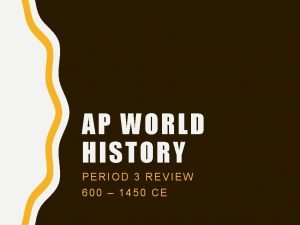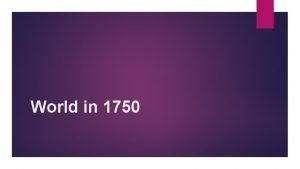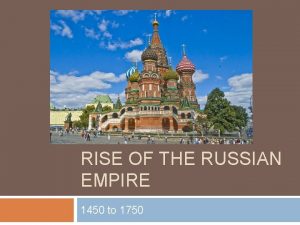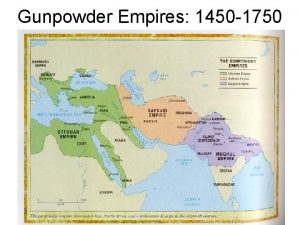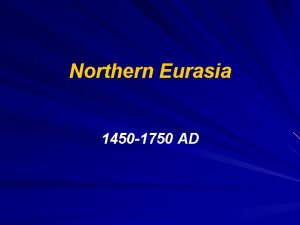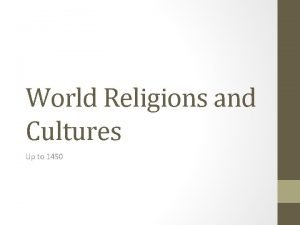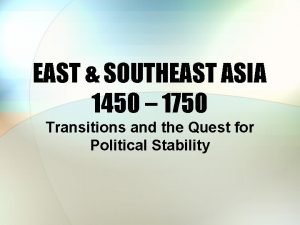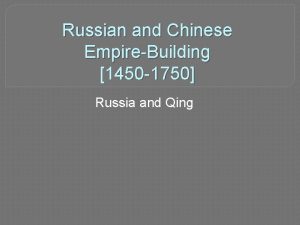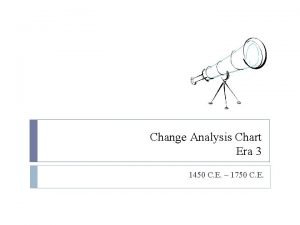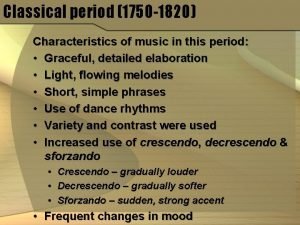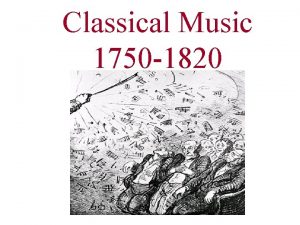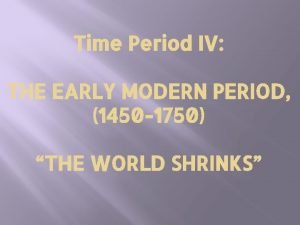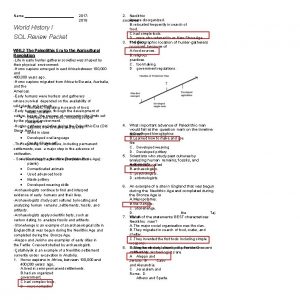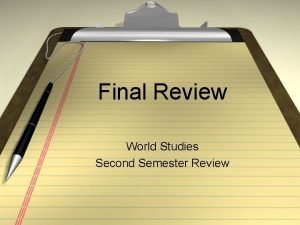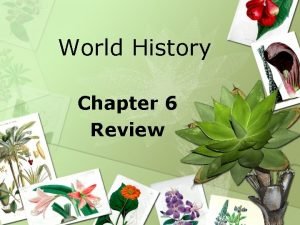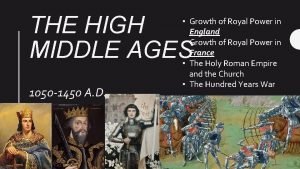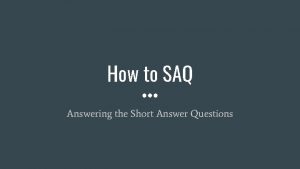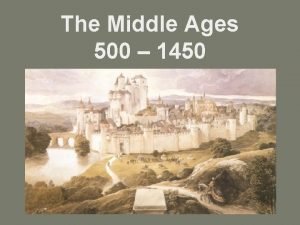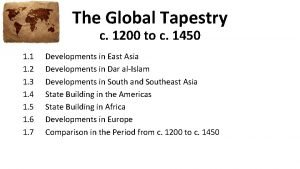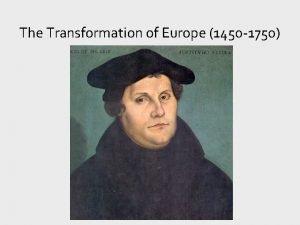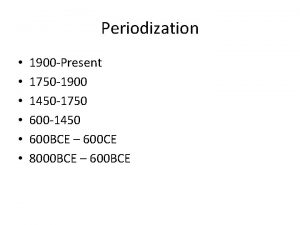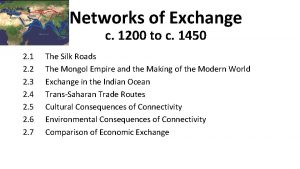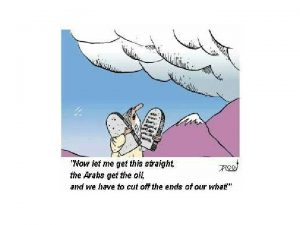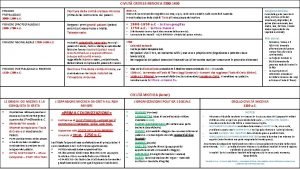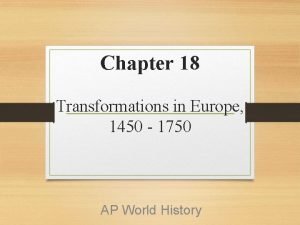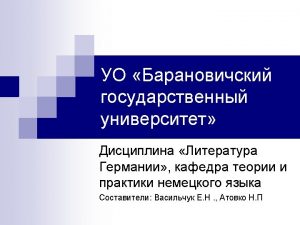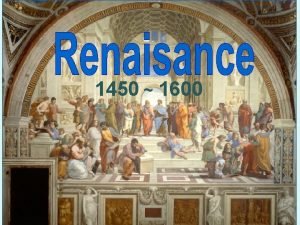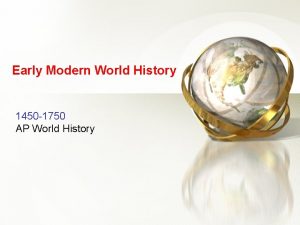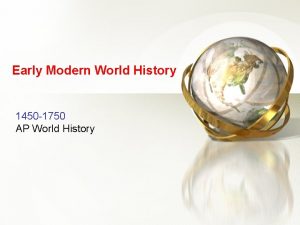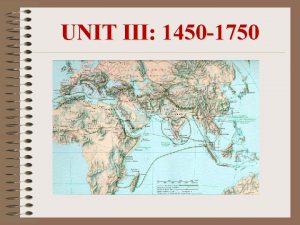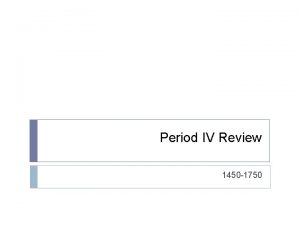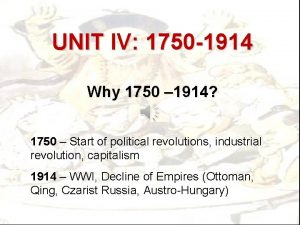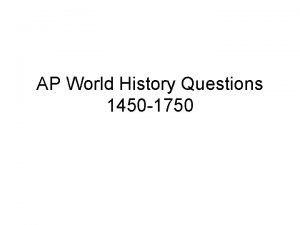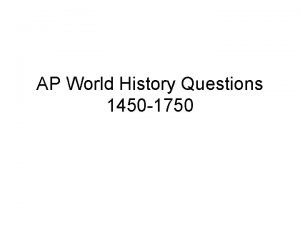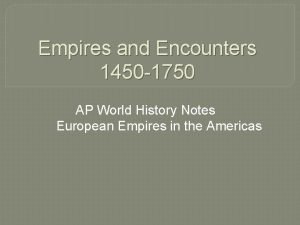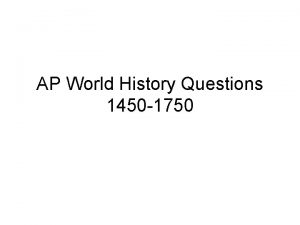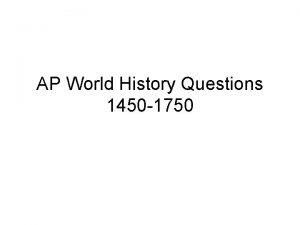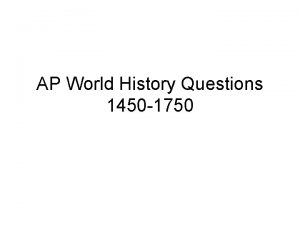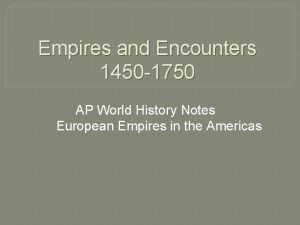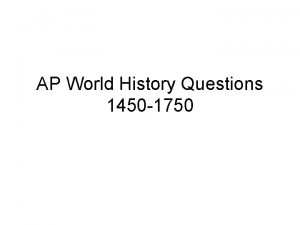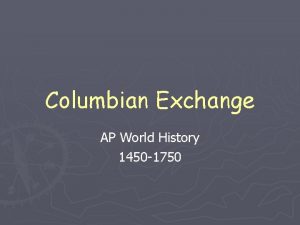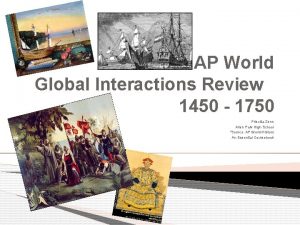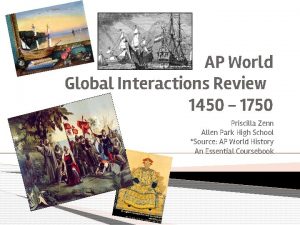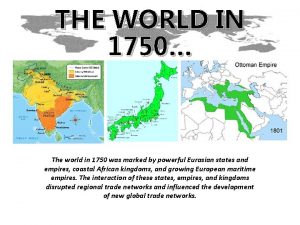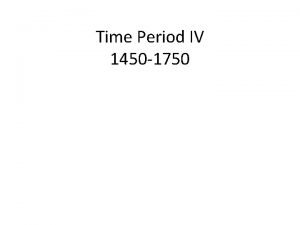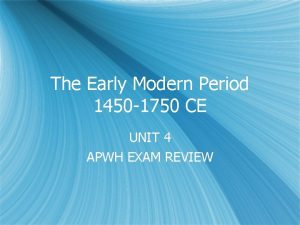AP WORLD HISTORY PERIOD 4 REVIEW 1450 1750








































- Slides: 40

AP WORLD HISTORY PERIOD 4 REVIEW 1450 - 1750 CE

EXAM STRUCTURE • 55 mins. – 70 multiple choice questions - Break - • 10 mins. – Read essay prompts and plan • 2 hrs. – Write 3 essays • Document Based Question • Continuity & Change Over Time • Comparison

PERIODS • Period 1: 8000 – 600 B. C. E. • Neolithic Revolution, River valley civilizations • Period 2: 600 B. C. E. – 600 C. E. • Greece, Rome, Han, Silk Road • Period 3: 600 – 1450 C. E. • Byzantines, Islam, Indian Ocean Trade • Period 4: 1450 – 1750 C. E. • European Exploration, Renaissance & Reformation • Period 5: 1750 – 1900 C. E. • Revolutions, Industry, Imperialism • Period 6: 1900 – Present • World Wars, Globalization

THEMES (S. P. I. C. E. ) • Social – Gender Roles, Social Classes, Ethnic Groups • Political – Types of Government, Wars, Laws, Revolts • Interaction between Humans and the Environment – Geography, Migration, Technology • Cultural – Religions, Philosophies, Science, Arts • Economic – Trade, Labor Systems, Industrialization

HISTORICAL SOURCES Historians are concerned with the examination of written records from the past. There are two types of sources that historians study: • Primary Source- A firsthand record of a historical event created by an eyewitness who actually experienced the event – (Examples- Diaries, photographs, artifacts, autobiographies) • Secondary Source- A secondhand record of a historical event created by a person who did NOT actually experience the event – (Examples- Textbooks, encyclopedias, biographies)

PERIOD 4 1450 -1750 CE Global Interactions – 20%

RENAISSANCE (1400 -1600) • The Renaissance was the Golden Age of Western Europe. The Renaissance had the following characteristics: – Like all Golden Ages, there were amazing achievements in the arts, literature, and science. – Renaissance scholars studied art and books from ancient Greece and Rome. – Humanism- There was a focus on humans and life on earth instead of on God and Heaven. • The Renaissance began in Italy because: – The Italian city-states (like Venice and Florence) had great economies. These areas controlled Mediterranean trade and grew very wealthy. Much of this wealth was used to support artists.

RENAISSANCE ARTISTS • Famous artists of the Renaissance include Donatello, Leonardo da Vinci, Michelangelo, and Raphael • Niccolo Machiavelli- Famous author of the Renaissance who wrote a book called “The Prince, ” which is a guide for government leaders. Key ideas of this book include: – Rulers must have absolute power and do whatever is necessary to stay in power (even if that means dishonest and cruel behavior). – “The end justifies the means”- Leaders must do whatever is necessary to help their nation.

PROTESTANT REFORMATION • 1500 s • The Protestant Reformation was the religious revolution that challenged the Catholic Church and led to the further division of Christianity. • Causes of the Protestant Reformation: – Europeans were angry that the Catholic Church was too concerned with worldly issues (i. e. - money and power). – Europeans were angry about indulgences- Reductions in punishment that were sold by the Catholic Church.

PROTESTANT REFORMATION • Key leaders of the Protestant Reformation: – Martin Luther- German monk who created the 95 Thesis, which were 95 arguments against the sale of indulgences. – Henry VIII- King of England who separated from the Catholic Church because he wanted a divorce from his wife and the Catholic Church would not allow it. – John Calvin- Swiss reformer who believed in predestination, which is the idea that God already knows who will be punished and who will be saved (i. e. - sent to Heaven).

PROTESTANT REFORMATION • Effects of the Protestant Reformation: – The power of the Catholic Church (and the Pope) decreased. – The power of monarchs (kings) increased since they gained power over religion. – Religious unity in Europe came to an end- Before the Protestant Reformation, almost everyone in Western Europe was Catholic. Now there were large numbers of Protestants too.

THE PRINTING PRESS • Invented by Johannes Gutenberg. • The printing press was important for several reasons: – It helped spread new ideas quickly. – It helped spread the Protestant Reformation since people like Martin Luther were able to print copies of their writings for others to read. – It increased literacy (the ability of people to read and write) since books were now easier and cheaper to obtain.

PRE-COLUMBIAN CIVILIZATIONS • c. 300 -1500 s • The pre-Columbian civilizations are the societies that developed in the Americas before the arrival of the Europeans. • The 3 main pre-Columbian societies were the Maya, the Aztec, and the Inca. They were all very organized, developed, and advanced civilizations.

THE MAYA • They lived in the lowland region of Mesoamerica (Mexico and Central America). • Achievements: – They developed a calendar and a form of writing. – Math- They invented the use of zero in math (like the Gupta of India).

THE AZTEC • They lived in Mesoamerica (Mexico) and established a large empire. • Tenochtitlan- Capital city of the Aztec Empire. • Achievements: – They used a calendar and a form of writing. – Chinampas- These were “floating gardens” that the Aztecs built in lakes in order to farm since there was a shortage of fertile land.

THE INCA • They lived in the Andes Mountains of Peru (South America) & established a large empire. • Machu Picchu- Most famous site of the Inca. • Achievements: – In order to improve trade and transportation, the Inca developed a vast large network of roads (like the Romans) and footbridges in the Andes Mountains. – Terrace Farming- Since the Inca lived in the mountains, they learned to farm by cutting flat areas (called terraces) into the sides of mountains. • NOTE: The Japanese used a similar technique in order to farm.

COMPARISON • Both the Aztecs and the Inca used creative agricultural techniques (chinampas and terrace farming) in order to adapt to their geographic environments. • The Aztecs and the Inca were both conquered by the Spanish when they arrived in the 1500 s: – The Aztecs- Conquered by Hernan Cortez in 1521. – The Inca- Conquered by Francisco Pizarro in 1532.

AGE OF EXPLORATION • 1400 s-1600 s • Europeans began sea voyages of exploration • Europeans reached the Americas and began to colonize (take over) areas in the Americas, Africa, and Asia. • The two European countries that first began voyages of exploration were Spain and Portugal.

AGE OF EXPLORATION • Causes of the Age of Exploration: – Europeans wanted greater access to the spices and other products of Asia. – Europeans wanted to find sea routes to Asia since land routes were controlled by Muslims. – Improvements in navigational (sailing) technology made long sea voyages possible. • compass • astrolabe • cartography (the science of making maps) • lateen sail for ships

AGE OF EXPLORATION • Key Explorers include: – Bartholomeu Dias- First explorer to round the Cape of Good Hope (southern tip of Africa). – Vasco da Gama- First explorer to reach India by going around Cape of Good Hope. – Christopher Columbus- First explorer to reach the Americas. – Ferdinand Magellan- First explorer to circumnavigate (sail around) the globe.

AGE OF EXPLORATION • Effects of the Age of Exploration: The Americas – The Spanish and Portuguese colonized land in the Americas. Lands controlled by the Spanish and Portuguese were called colonies. – Encomienda System- A labor system in which the Native Americans were forced to work on Spanish farming plantations (growing sugar) and in Spanish mines (getting gold and silver). • Spanish landowners had total control over the Native Americans. – Millions of Native Americans died due to the diseases (such as smallpox) brought over by the Europeans.

AGE OF EXPLORATION • Effects of the Age of Exploration: Africa – Europeans took slaves from Africa to the Americas to work on farming plantations. – The voyage of slaves from Africa to the Americas was called the Middle Passage.

AGE OF EXPLORATION • Effects of the Age of Exploration: Mercantilism – Mercantilism is the idea that colonies exist only to make the Mother Country (i. e. - Spain and Portugal) wealthy. – Spain and Portugal tightly controlled trade with their colonies in the Americas in order to make money. – Europeans would take raw materials (like cotton) from their American colonies and sell finished products (like clothing) back to the colonies.

AGE OF EXPLORATION • Effects of the Age of Exploration: Triangular Trade Route – trade route taken by Europeans in the Atlantic Ocean – Europeans traveled to Africa to get slaves, brought the slaves to their colonies in the Americas, and then returned to Europe with goods from the Americas

AGE OF EXPLORATION • Effects of the Age of Exploration: Columbian Exchange • exchange of people, plants, animals, ideas and technology between the “Old World” (Europe) and the “New World” (Americas) that took place as a result of exploration and colonization – Items sent from Europe to the Americas include: Wheat, sugar, bananas, horses, chickens and diseases (like smallpox and measles). – Items sent from the Americas to Europe include: Maize (corn), potatoes, beans, squash, chili peppers, cocoa, and tobacco. – The Columbian Exchange is the ultimate example of cultural diffusion (the exchange of goods and ideas between civilizations).

COMMERCIAL REVOLUTION • 1500 s-1600 s • new forms of business that were introduced during the Age of Exploration. These new forms of business included: – Joint-stock companies - Investors would combine money to help pay for trading projects. – The expansion (growth) of banking. – Capitalism - Form of business in which profits from one project are reinvested in other projects in order to make more money.

AGE OF ABSOLUTISM • 1600 s-1700 s • period in European history when nations were governed (ruled) by absolute monarchs. • The term “monarch” means “king. ” • Absolute monarchs were kings who had total control over the nations that they ruled.

AGE OF ABSOLUTISM • Key characteristics/features of absolute monarchs: – Absolute monarchs centralized political control, which means that they did not share power with anyone else. – Absolute monarchs believed in Divine Right, which was the idea that kings received their power to rule directly from God. – Absolute monarchs believed that their power was unlimited. They made laws without the consent (approval) of the people.

AGE OF ABSOLUTISM • Some important absolute monarchs include: – Peter the Great- He was the absolute monarch of Russia. He also westernized Russia, which means that he imitated the customs and traditions of countries in Western Europe in order to strengthen his nation. – Louis XIV- He was the absolute monarch of France. – Philip II- He was the absolute monarch of Spain. – Henry VIII- He was the absolute monarch of England. – Suleiman the Magnificent- He was the absolute monarch of the Ottoman Empire. – NOTE: In addition to knowing that these men were absolute monarchs, know that Peter the Great, Louis XIV, and Suleiman the Magnificent helped expand (enlarge) the territory of their nations by taking over neighboring lands.

ENGLISH REVOLUTION • 1689 • (also called the Glorious Revolution) • the people of England successfully limited the power of their monarchs (kings) • took place because people in England believed that the absolute monarchs of England were unfair and had too much power

ENGLISH REVOLUTION (1689) • Key effects of the English Revolution/Glorious Revolution: – England’s government became a limited (or constitutional) monarchy • form of government in which the power of monarchs (kings) is limited (decreased) by written laws. – Below is a list of laws that each limited the power of the English king in some way: • The Magna Carta • The Petition of Right • The English Bill of Rights • Habeas Corpus – NOTE: As a result of these laws, English kings had to share power with Parliament (the lawmaking body of the English

SCIENTIFIC REVOLUTION • 1500 s-1600 s • The Scientific Revolution was a sudden and dramatic change in how people viewed the world. • During the Scientific Revolution, science and reason (logic) were used to explain how the world worked. • People no longer turned only to the Bible and the Catholic Church for answers.

SCIENTIFIC REVOLUTION • Key people of the Scientific Revolution: – Copernicus- Astronomer who developed the Heliocentric Theory- The idea that the planets revolve around the sun. – Galileo Galilei- Astronomer who proved that Copernicus was correct. He was put on trial by the Catholic Church because his ideas contradicted (went against) its teachings. – Sir Isaac Newton- Mathematician and astronomer who developed calculus and theory of gravity. – Johannes Kepler- Astronomer who helped discover how planets move. – Descartes- Mathematician, scientist, and philosopher.

SCIENTIFIC REVOLUTION • Key effects of the Scientific Revolution: – It resulted in the spread of new ideas throughout Europe. – It challenged the traditional authority (power) of the Catholic Church since European scientists proved that many Church teachings were incorrect. – The new ideas of this period directly led to the Enlightenment

THE ENLIGHTENMENT (1700 S) • Period in European history when reason (logic) was used to understand improve society. In fact, the Enlightenment is often called “The Age of Reason. ” • Key ideas of the Enlightenment: – Enlightenment philosophers believed that society could be improved by using reason (logic) and natural law (universal rules that are always true). – Enlightenment philosophers believed that governments receive their authority (power) from the people (NOT from God). – Enlightenment philosophers believed in democracy (a gov’t where the people have a say). • NOTE: The Scientific Revolution and the Enlightenment

THE ENLIGHTENMENT (1700 S) • Key people of the Enlightenment: – John Locke- He believed that all people have natural rights (the right to life, liberty, and property). He also said that people have the right to overthrow governments that fail to protect these rights. – Baron de Montesquieu- In order to prevent kings from being too strong, he believed that power in government should be divided into three branches (executive, legislative, judicial) so that there is a separation of powers and a system of checks and balances. – Voltaire- He believed that everyone is entitled to freedom of speech and freedom of religion. – Rousseau- He believed that society is a social contract (an agreement in which all people agree to work for the common

THE ENLIGHTENMENT (1700 S) • Key effects (results) of the Enlightenment: – Since Enlightenment philosophers believed that people can overthrow unfair governments, the Enlightenment helped cause political revolutions in France, Latin America, and the United States – Enlightened Despots- These were European kings and queens who believed in Enlightenment ideas and ruled using Enlightenment principles (ideas).

DBQ PROMPT DBQ 2013 European Struggle for Power Analyze connections between regional issues and European struggles for global power in the mid-eighteenth century. Identify an additional type of document and explain how it would help your analysis of these connections.

CCOT PROMPT CCOT 2010 Religious Beliefs & Practices, 1450 -Present Describe and explain continuities and changes in religious beliefs and practices in ONE of the following regions from 1450 to the present. – Sub-Saharan Africa – Latin America/Caribbean

COMPARATIVE PROMPT C&C 2012 Columbian Exchange Compare demographic and environmental effects of the Columbian Exchange on the Americas with the Columbian Exchange’s demographic and environmental effects on ONE of the following regions between 1492 and 1750. – Africa – Asia – Europe
 Whap period 3
Whap period 3 Mughal empire 1450 to 1750
Mughal empire 1450 to 1750 Silver trade 1450 to 1750
Silver trade 1450 to 1750 Russian empire religion 1450 to 1750
Russian empire religion 1450 to 1750 Land based empires 1450 to 1750
Land based empires 1450 to 1750 Japan 1450-1750
Japan 1450-1750 Religion in 1450 to 1750
Religion in 1450 to 1750 Southeast asia 1450 to 1750
Southeast asia 1450 to 1750 Russia 1450 to 1750
Russia 1450 to 1750 Change analysis chart 1450 to 1750
Change analysis chart 1450 to 1750 Classical music has less complicated texture
Classical music has less complicated texture Franz joseph haydn characteristics of music
Franz joseph haydn characteristics of music 1750 to 1820 classical music
1750 to 1820 classical music What period lasted from 1750-1825?
What period lasted from 1750-1825? World map 1450
World map 1450 Ap world history period 2 test
Ap world history period 2 test World history spring final exam review answers
World history spring final exam review answers World history 1 sol review
World history 1 sol review World history semester 2 final review packet
World history semester 2 final review packet World history semester 1 exam review
World history semester 1 exam review World history chapter 6 review
World history chapter 6 review World history semester 1 final exam study guide answers
World history semester 1 final exam study guide answers World history semester 1 final exam study guide answers
World history semester 1 final exam study guide answers Ap world history jeopardy review game
Ap world history jeopardy review game Apwh final exam review
Apwh final exam review Ap world history chapter 25 africa and the atlantic world
Ap world history chapter 25 africa and the atlantic world History world tour
History world tour 1450 ad
1450 ad Best buy in st george utah
Best buy in st george utah Saq answer example
Saq answer example 500/1450
500/1450 C-1450-1
C-1450-1 Europe 1450
Europe 1450 1750+600
1750+600 C-1450-2
C-1450-2 1250 bc
1250 bc Prepalaziale
Prepalaziale Europe map 1750
Europe map 1750 Toreador fresco meaning
Toreador fresco meaning Important events in the renaissance
Important events in the renaissance Bürgerlicher realismus historischer hintergrund
Bürgerlicher realismus historischer hintergrund
